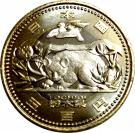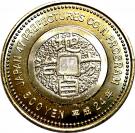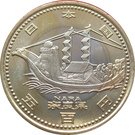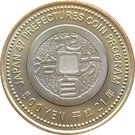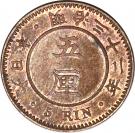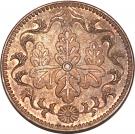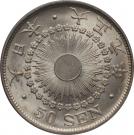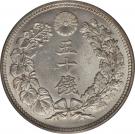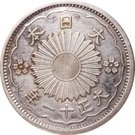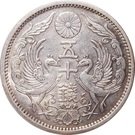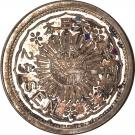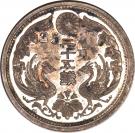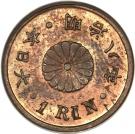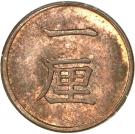Description:
Obverse
Sleeping cat and sparrows.
Sleeping Cat is a wooden figure placed in an entrance of the East Cloister of Nikko ToshōgūShrine. It is said to have been carved by Hidari Jingorō, a famous temple carpenter and sculptor. Behind the Sleeping Cat are sculptures of sparrows. There is one interpretation — that their co–existence on his work represented arrival of the peace era, after the end of the age of provincial wars in Japan, around that time. In addition, East Cloister of Nikko TōshogūShrine, where these sculptures are placed, was selected as a National Treasure together with Yōmei–mon Gate etc. in 1951.
Reverse
Shape of Japanese old coin
Related Coins
2 Sen - Meiji
Country: Japan / Denomination: 2 Sen
(0.02 JPY)
Year: 6-25 (1873-1892) / Material: Bronze
10 Sen - Taishō
Country: Japan / Denomination: 10 Sen
(0.1 JPY)
Year: 1-6 (1912-1917) / Material: Silver (.720)
500 Yen - Heisei (Okayama)
Country: Japan / Denomination: 500 Yen
500 JPY = 4.51 USD
Year: 25 (2013) / Material: Bi-Metallic Copper-nickel center in Nickel-brass ring
5 Momme - Meiwa
Country: Japan / Denomination: 5 Momme
(1/12)
Year: (1765-1768) / Material: Silver (.460)
500 Yen - Heisei (Nara)
Country: Japan / Denomination: 500 Yen
500 JPY = 4.51 USD
Year: 21 (2009) / Material: Bi-metallic Copper-nickel center in Brass ring
50 Sen - Taishō
Country: Japan / Denomination: 50 Sen
(0.5 JPY)
Year: 1-6 (1912-1917) / Material: Silver (.800)
50 Sen - Taishō
Country: Japan / Denomination: 50 Sen
(0.5 JPY)
Year: 11-15 (1922-1926) / Material: Silver (.720)
1 Rin - Meiji
Country: Japan / Denomination: 1 rin
(0.001 JPY)
Year: 6-25 (1873-1892) / Material: Bronze

